
original at www.af.mil |
C-130 - A historical photo of an older C-130
(U.S. Air Force Photo)
Four decades have elapsed since the Air Force issued its original design specification, yet the remarkable C-130 remains in production. The initial production model was the C-130A, with four Allison T56-A-11 or -9 turboprops. A total of 219 were ordered and deliveries began in December 1956. Two DC-130A's (originally GC-130A's) were built as drone launchers/directors, carrying up to four drones on underwing pylons. All special equipment was removable, permitting the aircraft to be used as freighters, assault transports, or ambulances. The C-130B introduced Allison T56-A-7 turboprops and the first of 134 entered Air Force service in April 1959. C-130B's are used in aerial fire fighting missions by Air National Guard and Air Force Reserve units. Six C-130B's were modified in 1961 for snatch recovery of classified U.S. Air Force satellites by the 6593rd Test Squadron at Hickam Air Force Base, Hawaii. |
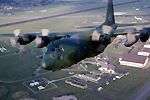
original at www.af.mil |
C-130 Hercules - Over RAF Mildenhall, UK
(U.S. Air Force photo by Master Sgt. Dave Nolan)
Four decades have elapsed since the Air Force issued its original design specification, yet the remarkable C-130 remains in production. The initial production model was the C-130A, with four Allison T56-A-11 or -9 turboprops. A total of 219 were ordered and deliveries began in December 1956. Two DC-130A's (originally GC-130A's) were built as drone launchers/directors, carrying up to four drones on underwing pylons. All special equipment was removable, permitting the aircraft to be used as freighters, assault transports, or ambulances. The C-130B introduced Allison T56-A-7 turboprops and the first of 134 entered Air Force service in April 1959. C-130B's are used in aerial fire fighting missions by Air National Guard and Air Force Reserve units. Six C-130B's were modified in 1961 for snatch recovery of classified U.S. Air Force satellites by the 6593rd Test Squadron at Hickam Air Force Base, Hawaii. |

original at www.af.mil |
AC-130 Spectre Gunship being refueled by KC-135
(U.S. Air Force photo by Technical Sgt. Jamie Bowman)
The AC-130 Spectre gunship's primary missions are close air support, air interdiction and armed reconnaissance. Other missions include perimeter and point defense, escort, landing, drop and extraction zone support, forward air control, limited command and control, and combat search and rescue. These heavily armed aircraft incorporate side-firing weapons integrated with sophisticated sensor, navigation and fire control systems to provide surgical firepower or area saturation during extended periods, at night and in adverse weather. The sensor suite consists of a low-light-level television sensor and an infrared sensor. Radar and electronic sensors also give the gunship a method of positively identifying friendly ground forces as well as effective ordnance delivery during adverse weather conditions. Navigational devices include an inertial navigation system and global positioning system. |
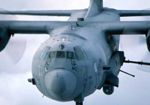
original at www.af.mil |
AC-130 gunship closeup
(U.S. Air Force photo by Master Sgt. Rose Reynolds)
Spectre has an impressive combat history. During Vietnam, gunships destroyed more than 10,000 trucks and were credited with many life-saving close air support missions. AC-130s suppressed enemy air defense systems and attacked ground forces during Operation Urgent Fury in Grenada. This enabled the successful assault of Point Salines airfield via airdrop and airland of friendly forces. The gunships had a primary role during Operation Just Cause in Panama by destroying Panamanian Defense Force Headquarters and numerous command and control facilities by surgical employment of ordnance in an urban environment. As the only close air support platform in the theater, Spectres were credited with saving the lives of many friendly personnel. During Operation Desert Storm, Spectres provided air base defense and close air support for ground forces. AC-130s were also used during Operations Continue Hope and United Shield in Somalia, providing close air support for United Nations ground forces. The gunships have most recently played a pivotal role during operations in support of the NATO mission in Bosnia-Herzegovina, providing air interdiction against key targets in the Sarajevo area. |
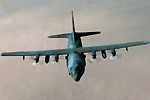
original at www.af.mil |
MC-130 over central Africa on rescue mission
(U.S. Air Force photo by Staff Sgt. Efrain Gonzalez)
A MC-130 Combat Talon approaches a KC-135 Stratotanker to refuel in flight as the two aircraft fly over the central region of Africa on Sept. 15, 1997. The MC-130 was carrying search and rescue teams from RAF Mildenhall, England, to Libreville, Gabon. Libreville was the staging area for U.S. air and sea rescue operations to find survivors from an Air Force C-141 cargo aircraft which crashed Sept. 13, 1997, near the Ascension Islands off of Africa's western coast. There were no survivors. |

original at www.af.mil |
Exercise Northern Edge '98 hones skills in Alaska
(Photo by Senior Airman Adam Wooten)
A C-130 from the 144th Airlift Squadron Alaska's Kulis Air National Guard Base prepares to takeoff from Fort Greely, Alaska. C-130s from the 144th and the 517th Airlift Squadron, Elmendorf Air Force Base, Alaska, flew 99 missions in support of Northern Edge '98 and carried more than 1,400 passengers and transported over 660,000 pounds of equipment in the first four days of the exercise. |
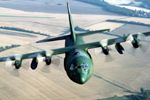
original at www.af.mil |
C-130E - Front view of a Hercules flying low-level
(U.S. Air Force photo by Master Sgt. Dave Nolan)
In its personnel carrier role, the C-130 can accommodate 92 combat troops or 64 fully equipped paratroops on side-facing seats. For medical evacuations, it carries 74 litter patients and two medical attendants. Paratroopers exit the aircraft through two doors on either side of the aircraft behind the landing-gear fairings. Another exit is off the rear ramp for airdrops. |
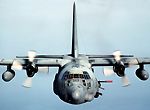
original at www.af.mil |
AC-130 Gunship
(U.S. Air Force photo)
The AC-130 Spectre gunship's primary missions are close air support, air interdiction and armed reconnaissance. Other missions include perimeter and point defense, escort, landing, drop and extraction zone support, forward air control, limited command and control, and combat search and rescue. These heavily armed aircraft incorporate side-firing weapons integrated with sophisticated sensor, navigation and fire control systems to provide surgical firepower or area saturation during extended periods, at night and in adverse weather. The sensor suite consists of a low-light-level television sensor and an infrared sensor. Radar and electronic sensors also give the gunship a method of positively identifying friendly ground forces as well as effective ordnance delivery during adverse weather conditions. Navigational devices include an inertial navigation system and global positioning system. |

original at www.af.mil |
C-130 flies over North Carolina
(U.S. Air Force photo by Technical Sgt. Howard Blair)
A C-130 Hercules from the 2nd Airlift Squadron, Pope Air Force Base, North Carolina, flies a training mission. The C-130 primarily performs the intratheater portion of the airlift mission. The aircraft is capable of operating from rough, dirt strips and is the prime transport for paradropping troops and equipment into hostile areas. |

original at www.af.mil |
C-130 Hercules from the 2nd Airlift Squadron
(U.S. Air Force photo by Technical Sgt. Howard Blair)
A C-130 Hercules from the 2nd Airlift Squadron, Pope Air Force Base, North Carolina, flies a training mission. The C-130 primarily performs the intratheater portion of the airlift mission. The aircraft is capable of operating from rough, dirt strips and is the prime transport for paradropping troops and equipment into hostile areas. |
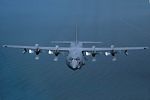
original at www.af.mil |
AC-130 Spectre gunship on a training mission
(U.S. Air Force photo )
The AC-130 Spectre gunship's primary missions are close air support, air interdiction and armed reconnaissance. Other missions include perimeter and point defense, escort, landing, drop and extraction zone support, forward air control, limited command and control, and combat search and rescue. These heavily armed aircraft incorporate side-firing weapons integrated with sophisticated sensor, navigation and fire control systems to provide surgical firepower or area saturation during extended periods, at night and in adverse weather. |

original at www.af.mil |
4th Special Operations Squadron AC-130U Spooky Gunship
(U.S. Air Force Photo)
The AC-130U Spooky gunship's primary missions are close air support, air interdiction and armed reconnaissance. Other missions include perimeter and point defense, escort, landing, drop and extraction zone support, forward air control, limited command and control, and combat search and rescue. The U-model gunship is one of the most complex aircraft weapon systems in the world today, containing more than 609,000 lines of software in its mission computers and avionics systems. Although it still uses the venerable Lockheed C-130 airframe, the AC-130U incorporates the latest sensor technology, along with an entirely new fire-control system, to substantially increase the gunship's combat effectiveness. The fire control system offers a dual-target attack capability, whereby two targets up to one kilometer apart can be simultaneously engaged by two different sensors, using two different guns. All light-level television, infrared sensors, and the Hughes APQ-180 radar (also found on the F-15E Strike Eagle) provide night and adverse weather capability. To enhance survivability, emphasis has been placed on increasing the stand-off range of the gunship's weapons system and improving first-shot accuracy. In addition, a set of electronic countermeasures has been installed to help defend the AC-130U against modern threats. The AC-130U is armed with a 25mm Gatling-gun cannon (capable of firing 1800 rounds per minute), a single-barrel, rapid-fire 40mm Bofors cannon and a 105mm Howitzer. |
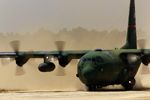
original at www.af.mil |
Rodeo 2000- C-130 Dirt Landing
(U.S. Air Force Photo by Staff Sgt. Jeff Allen)
A C-130 Hercules from the 165th Air Wing, Savannah, GA, performs an assault landing on a dirt landing strip at Holland Drop Zone, NC, on Monday, May 8, 2000. The assault landing competition is part of Rodeo 2000. During Rodeo 2000, teams from all over the world compete in areas including airdrop, aerial refueling, aircraft navigation, special tactics, short field landings, cargo loading, engine running on/offloads, aeromedical evacuations and security forces operations. From May 6 to 13, more than 80 aircraft representing more than 100 teams from 17 countries will bring in about 3,500 competitors, observers, umpires, and support people to Pope AFB, NC. |
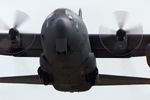
original at www.af.mil |
Rodeo 2000- A C-130 Hercules takes off from Pope AFB
(U.S. Air Force Photo by Staff Sgt. Jeff Allen)
A C-130 Hercules takes off from Pope AFB, NC, on Tuesday, May 9, 2000. The C-130 and it's crew are deployed to Pope AFB to participate in Airlift Rodeo 2000. During Rodeo 2000, teams from all over the world compete in areas including airdrop, aerial refueling, aircraft navigation, special tactics, short field landings, cargo loading, engine running on/offloads, aeromedical evacuations and security forces operations. From May 6 to 13, more than 80 aircraft representing more than 100 teams from 17 countries will bring in about 3,500 competitors, observers, umpires, and support people to Pope AFB, NC. |

original at www.af.mil |
4th SOS AC-130U Spooky gunship
(U.S. Air Force Photo by Staff Sgt. Andy Dunaway)
The 4th Special Operations Squadron is the largest of eight flying squadrons within the 16th Special Operations Wing at Hurlburt Field, Fla. The squadron employs the AC-130U Spooky gunship for close air support, armed reconnaissance, and interdiction missions in support of conventional and joint special operations forces. The AC-130U is the very latest in a distinguished line of gunships. The gunship adopted its Spooky nickname from the AC-47, the original, first-generation gunship. The U-model gunship is one of the most complex aircraft weapon systems in the world today, containing more than 609,000 lines of software in its mission computers and avionics systems. Although it still uses the venerable Lockheed C-130 airframe, the AC-130U incorporates the latest sensor technology, along with an entirely new fire-control system, to substantially increase the gunship's combat effectiveness. The fire control system offers a dual-target attack capability, whereby two targets up to one kilometer apart can be simultaneously engaged by two different sensors, using two different guns. All light-level television, infrared sensors, and the Hughes APQ-180 radar (also found on the F-15E Strike Eagle) provide night and adverse weather capability. |
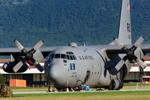
original at www.af.mil |
C-130 Hercules continues vital role in Bosnia
(U.S. Air Force Photo by Senior Airman Aaron D. Allmon II)
A C-130E Hercules of the 86th Airlift Wing, Ramstein Air Base, stands ready at Aviano Air Base, Italy to fly an Army airborne unit into Bosnia-Herzegovina, during Rapid Resolve II. The C-130 Hercules primarily performs the tactical portion of the airlift mission. The aircraft is capable of operating from rough, dirt strips and is the prime transport for airdropping troops and equipment into hostile areas. In its personnel carrier role, the C-130 can accommodate 92 combat troops or 64 fully-equipped paratroops on side-facing seats. |

original at www.af.mil |
MC-130P Combat Shadow
(U.S. Air Force Photo)
The Combat Shadow flies clandestine or low visibility, single or multi-ship low-level missions intruding politically sensitive or hostile territory to provide air refueling for special operations helicopters. The MC-130P primarily flies missions at night to reduce probability of visual acquisition and intercept by airborne threats. When modifications are completed in Fiscal 2000, all MC-130P's will feature improved navigation, communications, threat detection and countermeasures systems. When fully modified, the Combat Shadow fleet will have a fully-integrated inertial navigation and global positioning system, and night vision goggle compatible interior and exterior lighting. It will also have forward looking infrared, radar and missile warning receivers, chaff and flare dispensers, night vision goggle compatible heads-up display, satellite and data-burst communications, as well as in-flight refueling capability as a receiver (on 15 aircraft). |
^^ TOP ^^
|

